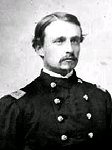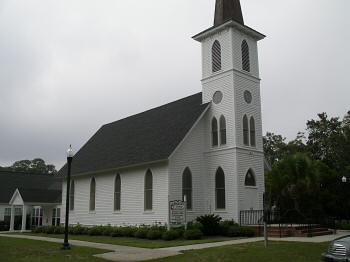|
Darien, established on the mighty
Altamaha River in 1736 by Scottish Highlanders, saw some of the first
action of black troops in the Civil War when Federals looted and burned
the town "to the ground" on June 11, 1863. Involved in the action was the
2nd South Carolina and the Massachusetts 54th, the U.S.C.T. regiment
commanded by 25-year-old Col. Robert Gould Shaw and made famous in the
movie Glory. Darien was an important shipping port before the War,
exporting cotton grown inland and rafted down the river. During the War,
the port was used by blockade runners and consisted of 75 to 100
residences, including three churches, a market house, a courthouse, and an
academy.
 Shaw's
troops, stationed on St. Simons Island June 10-24, 1863, were ordered to
Darien by Col. James Montgomery. The next day, the town was looted and
burned, with the light from the fires visible from St. Simons Island, 15
miles away. Col. Shaw, the son of a famous Boston abolitionist, did not
approve of burning the town and wrote letters to superiors about his
feelings on the matter. Twenty-five days after leading troops to Darien,
Shaw would be dead and buried in a mass grave with many of his men. He led
the Massachusetts 54th on a suicidal assault of Battery Wagner, South
Carolina, forever proving the battle courage of black troops in U.S.
history. Shaw's
troops, stationed on St. Simons Island June 10-24, 1863, were ordered to
Darien by Col. James Montgomery. The next day, the town was looted and
burned, with the light from the fires visible from St. Simons Island, 15
miles away. Col. Shaw, the son of a famous Boston abolitionist, did not
approve of burning the town and wrote letters to superiors about his
feelings on the matter. Twenty-five days after leading troops to Darien,
Shaw would be dead and buried in a mass grave with many of his men. He led
the Massachusetts 54th on a suicidal assault of Battery Wagner, South
Carolina, forever proving the battle courage of black troops in U.S.
history.
Darien recovered from the Civil War to become the second largest lumber
shipping port on the southern coast from 1870-1910. When timber resources
were depleted, Darien became what it is today, a fishing village.
Thirty-two historic sites are featured in a driving tour available at the
Welcome Center. The only remains from the Civil War days are some tabby
ruins, constructed from 1815-30, near the river on the west side of the
bridge at Broad Street. Darien was the birthplace of John McIntosh Kell, a
famed Confederate naval officer, who was executive officer of the Alabama
throughout its brilliant career, and was present at its sinking at the
hands of the Kearsarge off Cherbourge, France.
 Letter from Col. Shaw
about the raid at Darien, Georgia Letter from Col. Shaw
about the raid at Darien, Georgia |
 Shaw's
troops, stationed on St. Simons Island June 10-24, 1863, were ordered to
Darien by Col. James Montgomery. The next day, the town was looted and
burned, with the light from the fires visible from St. Simons Island, 15
miles away. Col. Shaw, the son of a famous Boston abolitionist, did not
approve of burning the town and wrote letters to superiors about his
feelings on the matter. Twenty-five days after leading troops to Darien,
Shaw would be dead and buried in a mass grave with many of his men. He led
the Massachusetts 54th on a suicidal assault of Battery Wagner, South
Carolina, forever proving the battle courage of black troops in U.S.
history.
Shaw's
troops, stationed on St. Simons Island June 10-24, 1863, were ordered to
Darien by Col. James Montgomery. The next day, the town was looted and
burned, with the light from the fires visible from St. Simons Island, 15
miles away. Col. Shaw, the son of a famous Boston abolitionist, did not
approve of burning the town and wrote letters to superiors about his
feelings on the matter. Twenty-five days after leading troops to Darien,
Shaw would be dead and buried in a mass grave with many of his men. He led
the Massachusetts 54th on a suicidal assault of Battery Wagner, South
Carolina, forever proving the battle courage of black troops in U.S.
history. 


